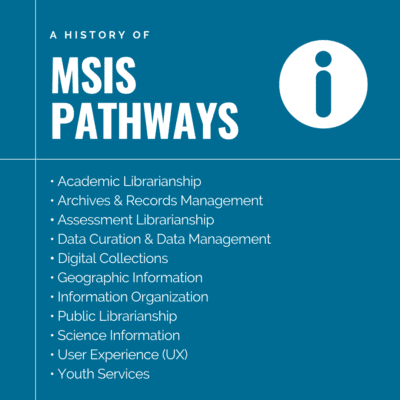Master’s Pathways Prepare Students for Careers in Information

Because the Master of Science in Information Sciences program prepares students for employment in so many settings – including scientific, corporate, academic, nonprofit, and more – it’s important to understand the many ways in which information sciences skills are applied.
Several years ago, the School of Information Sciences faculty decided to create “Career Pathways” to make it easier for prospective and current master’s students to understand the varying opportunities within the field. The Career Pathways went live in fall 2016.
The SIS pathways were carefully curated by individual faculty, each one taking into consideration their own experiences and education to carefully craft the types of courses and opportunities that would help a student enter their desired field upon graduating with their Master of Science in Information Sciences (MSIS) degree. The current MSIS pathways are:
- Academic Librarianship
- Archives & Records Management
- Assessment Librarianship
- Data Curation and Data Management
- Digital Collections
- Geographic Information
- Information Organization
- Public Librarianship
- Science Information
- User Experience (UX)
- Youth Services
Associate Professor Rachel Fleming-May has been the Director of Graduate Studies since 2017, and this year she is assisting new faculty member Clinical Assistant Professor Ericka Patillo in her transition into the Director of Graduate Studies role. Together, they clarified what a pathway is and how prospective and current students can use the pathways.
“A lot of people do have a misapprehension that it’s more like a concentration or major, but we don’t offer those—everyone graduates with the ALA-accredited MSIS degree,” Fleming-May said. “The pathways are meant to provide information and guidance for prospective students and students interested in exploring different areas. They also help us, as advisors.”
Patillo said the pathways are akin to an informational interview, wherein a student interviews a person in a career that student desires to have.
“I say, go talk to somebody who is doing that job, and see what they did to get that job; these pathways are similar to that,” Patillo said.
There isn’t a pathway for every single possible career someone with an MSIS can enter, and both Fleming-May and Patillo said prospective students should definitely ask them questions about anything that doesn’t seem to be listed underneath the current pathways. The same goes for current students – if there’s something they want to do, their advisors should be the first touchpoint to guide them.
Fleming-May said one of the advantages of the pathways is they provide suggestions for courses, including some that may be outside of SIS. Students are allowed to take up to nine hours of courses outside of SIS, and there are courses that could enhance their skills if they have a specific idea of what they want to do after graduation.
“It can be difficult to locate relevant classes elsewhere in the University and I think that this is a valuable contribution. Sometimes there are things that wouldn’t necessarily occur to students, like taking a course in administration and governance of higher education if you’re going into academic libraries,” Fleming-May said. “I took those courses in my PhD program and I wished I’d taken them before I worked as an academic librarian.”
Fleming-May actually created the Academic Libraries pathway, so she infused it with knowledge she gained from her own graduate experience, as well as from when she worked as an academic librarian. That is the value of these pathways – faculty bring a holistic view of what will best benefit a student in achieving their career goals, and laying it out in the pathways as a loose guide.
For example, besides courses, the pathways include information about other opportunities for students to enhance their graduate education, such as practicums, involvement in student groups and professional organizations, and more.
“There’s a lot of value in each pathway that is not related to classes – associations that are relevant, the titles of potential positions; I think that’s very useful information that has been curated by faculty,”Patillo said.
More than one student has started out thinking they’ll pursue one pathway, only to find a passion in another. There’s no pathway commitment, and students can change their minds mid-program without it affecting their degree or graduation.
Pathways grow from existing curriculum, they do not drive the curriculum, Fleming-May said. “The SIS curriculum is always changing and growing, there’s not a year or even really a semester where we don’t have a new or different class. There are some pathways that have become viable because a critical mass of classes in that area have been added, like Assessment Librarianship, as well as the User Experience (UX) pathway,” she said.
What students should always do when wondering what courses to take or what other moves to make regarding their schooling, is consult their advisors, said both Fleming-May and Patillo.